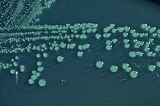
Shigella boydii
Encyclopedia
Shigella boydii is a Gram-negative
bacteria
of the genus Shigella
. Like other member of the genus
, S. boydii is a non-motile
, non-sporeforming, rod-shaped bacteria which can cause dysentery
in humans through fecal-oral
contamination.
S. boydii is the most genetically-divergent of the Shigella genus. There are 18 known serotype
s of Shigella boydii. Shigella boydii is restricted to the Indian subcontinent
.
The species is named after the American bacteriologist Mark Frederick Boyd
.
Gram-negative
Gram-negative bacteria are bacteria that do not retain crystal violet dye in the Gram staining protocol. In a Gram stain test, a counterstain is added after the crystal violet, coloring all Gram-negative bacteria with a red or pink color...
bacteria
Bacteria
Bacteria are a large domain of prokaryotic microorganisms. Typically a few micrometres in length, bacteria have a wide range of shapes, ranging from spheres to rods and spirals...
of the genus Shigella
Shigella
Shigella is a genus of Gram-negative, nonspore forming, non-motile, rod-shaped bacteria closely related to Escherichia coli and Salmonella. The causative agent of human shigellosis, Shigella causes disease in primates, but not in other mammals. It is only naturally found in humans and apes. During...
. Like other member of the genus
Genus
In biology, a genus is a low-level taxonomic rank used in the biological classification of living and fossil organisms, which is an example of definition by genus and differentia...
, S. boydii is a non-motile
Motility
Motility is a biological term which refers to the ability to move spontaneously and actively, consuming energy in the process. Most animals are motile but the term applies to single-celled and simple multicellular organisms, as well as to some mechanisms of fluid flow in multicellular organs, in...
, non-sporeforming, rod-shaped bacteria which can cause dysentery
Dysentery
Dysentery is an inflammatory disorder of the intestine, especially of the colon, that results in severe diarrhea containing mucus and/or blood in the faeces with fever and abdominal pain. If left untreated, dysentery can be fatal.There are differences between dysentery and normal bloody diarrhoea...
in humans through fecal-oral
Fecal-oral route
The fecal-oral route, or alternatively, the oral-fecal route or orofecal route is a route of transmission of diseases, in which they are passed when pathogens in fecal particles from one host are introduced into the oral cavity of another potential host.There are usually intermediate steps,...
contamination.
S. boydii is the most genetically-divergent of the Shigella genus. There are 18 known serotype
Serotype
Serotype or serovar refers to distinct variations within a subspecies of bacteria or viruses. These microorganisms, viruses, or cells are classified together based on their cell surface antigens...
s of Shigella boydii. Shigella boydii is restricted to the Indian subcontinent
Indian subcontinent
The Indian subcontinent, also Indian Subcontinent, Indo-Pak Subcontinent or South Asian Subcontinent is a region of the Asian continent on the Indian tectonic plate from the Hindu Kush or Hindu Koh, Himalayas and including the Kuen Lun and Karakoram ranges, forming a land mass which extends...
.
The species is named after the American bacteriologist Mark Frederick Boyd
Mark Frederick Boyd
Mark Frederick Boyd was an American Bacteriologist who discovered a shigella species known as shigella boydii....
.
Sequenced genomes
- Shigella boydii4 strain BS512 (serotype 18; group 1): 1 chromosome; 5 plasmidPlasmidIn microbiology and genetics, a plasmid is a DNA molecule that is separate from, and can replicate independently of, the chromosomal DNA. They are double-stranded and, in many cases, circular...
s
External links
- Shigella boydii Genome Project Page — by EntrezEntrezThe Entrez Global Query Cross-Database Search System is a powerful federated search engine, or web portal that allows users to search many discrete health sciences databases at the National Center for Biotechnology Information website...

